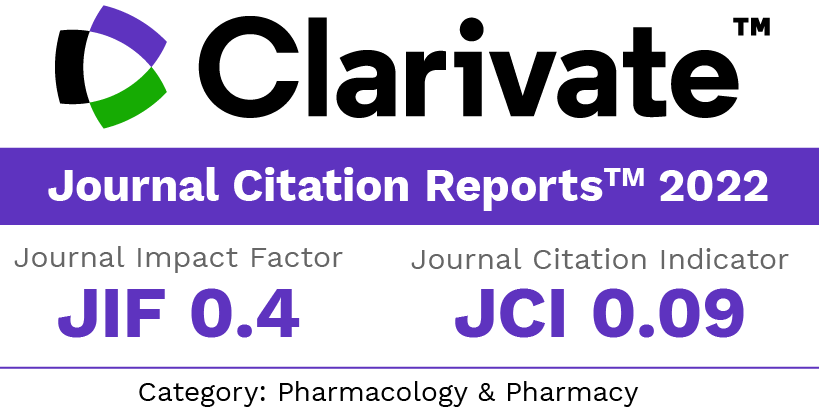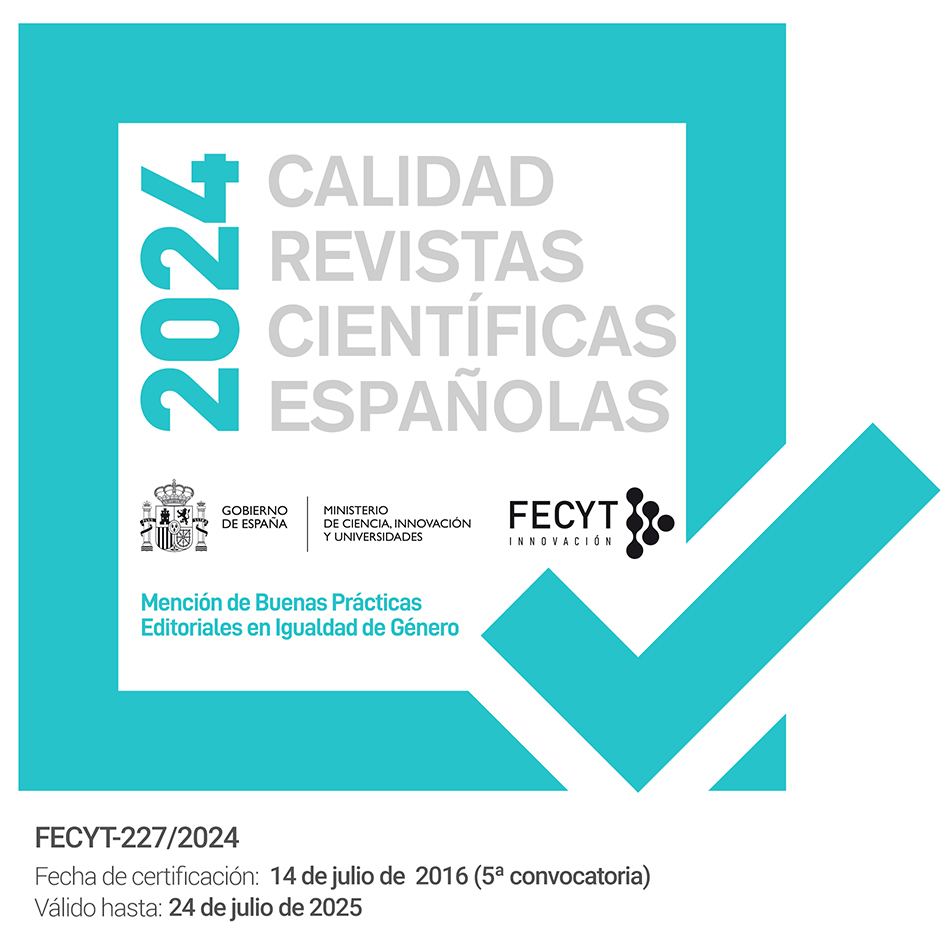Antiaterogenicidad in vitro de extractos del alga marina Halimeda incrassata: actividad antioxidante y estudios de migración en células de la musculatura lisa
Palabras clave:
antiaterogenicidad, H. incrassata, actividad antioxidante, células de musculatura lisaResumen
Objetivos: El objetivo de este trabajo fue evaluar el potencial ateroprotector in vitro del alga Halimeda incrassata en la migración de células de músculo liso de ratón y la oxidación de lipoproteínas en relación con su actividad antioxidante.
Material y métodos: La actividad antioxidante fue determinada mediante los métodos de inhibición de radicales DPPH y la Capacidad antioxidante total (ORAC). La actividad inhibitoria de la oxidación de LDL mediada por iones Cu2+ se determinó por la cuantificación de TBARS y dienos conjugados. El efecto del extracto acuoso sobre la migración de las células de músculo liso se evaluó en la línea de células de músculo liso aórtica de ratón MOVAS-1.
Resultados: Se demostró el efecto inhibidor del extracto sobre la oxidación de LDL mediada por Cu2+. El extracto del alga causa inhibición dosis-dependiente de la formación de TBARS (IC50 = 0,8 mg/mL) y dienos conjugados. Las algas tuvieron una alta actividad antioxidante en los ensayos realizados y podría estar relacionada con el contenido de compuestos fenólicos.
Conclusiones: Los resultados de este trabajo representan un paso más en la caracterización de la acción ateroprotectora de Halimeda incrassata y evidencian sus posibles aplicaciones como nutracéutico y/o fitofármaco.
Descargas
Citas
Fernández-Britto JE. La lesión aterosclerótica: estado del arte a las puertas del siglo XXI. Rev Cub Invest Biomed. 1998; 17(2):112-27.
Stocker R, Keaney JF. Role of Oxidative Modifications in Atherosclerosis. Physiol Rev. 2004; 84: 1381–1478.
O’Sullivan L, Murphy B, McLoughlin P, Duggan P, Lawlor PG, Hughes H, Gardiner GE. Prebiotics from Marine Macroalgae for Human and Animal Health Applications. Mar. Drugs 2010; 8, 2038-2064.
Bocanegra A, Bastida S, Benedí J, Ródenas S and Sánchez-Muniz FJ. Characteristics and Nutritional and Cardiovascular-Health Properties of Seaweeds. J Med Food 2009; 12 (2): 236–258
Rivero F, Fallarero A, Castañeda O, Dajas F, Manta E, Areces F, Mancini Filho J, Vidal A. Antioxidant activity in vivo and in vitro of Halimeda incrassata aqueous extracts. Cienc Tecnol Aliment Campinas. 2003; 23:256-263.
Fallarero A, Loikkanen J J, Mannisto PT, Castañeda O, Vidal A. Effects of aqueous extracts of Halimeda incrassata (Ellis) Lamouroux and Bryothamnion triquetrum (S.G.Gmelim) Howe on hydrogen peroxide and methyl mercury-induced oxidative stress in GT1-7 mouse hypothalamic immortalized cells. Phytomedicine. 2003; 10: 39-47.
Barro R, Zaldivar C, Fallarero A, Vidal V. Evaluation of the antioxidant activity in an aqueous extract of a red seaweed specie from the Caribbean sea Bryothamnion triquetrum. Rev Cub Quim. 2001; XIII (2):40.
Krygier K, Sosulski F, Hogge L. Free, esterified, and insoluble-bound phenolic acids. 1.Extraction and purification procedure. J Agric Food Chem. 1982;30: 330-334.
Vidal A, Silva de Andrade-Wartha ER, de Oliveira e Silva AM, Pavan R, Lima A, Fallarero A, Batista AE, Mancini-Filho J. Actividad antioxidante y polifenoles de las algas marinas Halimeda opuntia y Halimeda monile. Ars Pharm. 2009; 50(1): 24-31.
Goupy P, Hugues M, Boivin P, Amiot MJ. Antioxidant composition and activity of barley (Hordeum vulgare) and malt extracts and of isolated phenolic compounds. J Sci Food Agric. 1999; 79:1625-1634.
Gillespie KM, Chae JM, Ainsworth EA. Rapid measurement of total antioxidant capacity in plants. Nature Protocols. 2007; 2(4):867-870.
Frostegard J, Nilsson J, Haegerstrand A, Hamsten A, Wigzell H, Gidlund M. Oxidized low density lipoprotein induces differentation and adhesion of human monocytes and the monocytic cell line U937. PNAS. 1990; 87: 904-908.
Esterbauer HG, Striegl H, Puhl M, Rotheneder. Continuous monitoring of in vitro oxidation of human Low Density Lipoprotein. Free Rad Res. 1979; 6 (1): 67-75.
Pinchuk I, Lichtenberg D. The mechanism of action of antioxidants against lipoprotein peroxidation, evaluation based on kinetic experiments. Prog Lipid Res. 2002; 41:279-314.
Ho HH, Hsu LS, Chan KC, Chen HM, Wu CH, Wang CJ. Extract from the leaf of Nelumbo nucifera reduced the development of atherosclerosis via inhibition of vascular smooth muscle cell proliferation and migration. Food Chem Toxicol. 2010;48: 159–168.
Goncharova EA, Goncharov DA, Krymskaya VP. Assays for in vitro monitoring of human airway smooth muscle (ASM) and human pulmonary arterial vascular smooth muscle (VSM) cell migration. Nature Protocols. 2006; 1(6): 2936-2939.
Yoshie Y, Wang W, Hsieh YP, Suzuki T. Compositional difference of phenolic compounds between two seaweeds, Halimeda spp. J. Tokyo University of Fisheries. 2002; 88: 21-24.
Heo JS, Park EJ, Lee KW, Jeon YJ. Antioxidant activities of enzymatic extracts from brown seaweeds. Bioresour Technol. 2005; 96:1613–1623.
Barro R. Estudio de la actividad antioxidante y hepatoprotectora del extracto acuoso de Bryothamnion triquetrum. [Tesis de Máster en Bioquímica]: Universidad de La Habana; 2004.
Senevirathne M, Kim S, Siriwardhana N, Ha J, Lee K, Jeon Y. Antioxidant potential of Ecklonia cava Kjellman (P)on reactive oxygen species scavenging, metal quelating, reducing power and lipid peroxidation inhibition. Food Sci Tech Int. 2006;12(1):27-38.
Prior R L, Hoang H, Gu L, Wu X, Bacchiocca M, Howard L, Hapsch-Woodill M, Huang D, Ou B, Jacob R. Assays for hydrophilic and lipophilic antioxidant capacity (oxygen radical absorbance capacity (ORACFL)) of plasma and other biological and food samples. J Agric Food Chem. 2003; 51: 3273-3279.
Price JA, Sanny CG, Shevlin D. Application of manual assessment of oxygen radical absorbent capacity (ORAC) for use in high throughput assay of ‘‘total’’ antioxidant activity of drugs and natural products. J Pharmacol Toxicol Methods. 2006; 54: 56-61.
Vidal A, Silva de Andrade-Wartha, Fallarero A, de Oliveira AM, Vuorela P, Mancini-Filho J. Antioxidant activity and bioactive components from the seaweed Halimeda incrassata (Ellis) Lamouroux. Braz J Pharmacogn. 2011; 21(1): 53-57.
Amann R, Peskar BA. Anti-inflammatory effects of aspirin and sodium salicylate. Eur J Pharmacol. 2002; 447: 1-9.
Hseu YC, Chang WH, Chen CS, Liao JW, Huang CJ, Lu FJ, Chia YC, Hsu HK, Wu JJ, Yang HL. Antioxidant activities of Toona Sinensis leaves extracts using different antioxidant models. Food Chem Toxicol. 2008; 46: 105-114.
Ross R. Atherosclerosis-an inflammatory disease. N Engl J Med.1999; 340:115–126.
Kreuzer J, Viedt C, Brandes RP, Seeger F, Rosenkranz AS, Sauer H, Babich H, Nürnberg B, Kather H, Krieger-Brauer HI. Platelet-derived growth factor activates production of reactive oxygen species by NAD(P)H-oxidase in smooth muscle cells through Gi1,2. FASEB J. 2003 17(1):38-40.
Lee KW, Kang NJ, Oak MH, Hwang MK, Kim JH, Schini-Kerth VB, Lee HJ. Cocoa procyanidins inhibit expression and activation of MMP-2 in vascular smooth muscle cells by direct inhibition of MEK and MT1-MMP activities. Cardiovasc Res. 2008; 79(1):34-41.
Nie L, Wise ML, Peterson DM, Meydani M. Avenanthramide, a polyphenol from oats, inhibits vascular smooth muscle cell proliferation and enhances nitric oxide production. Atherosclerosis. 2006; 186: 260–266.
Zargham H, Zargham R. Tannin extracted from Sumac inhibits vascular smooth muscle cell migration. Mcgill J Med. 2008; 11(2): 119-123.
Zaldivar C, Costa A, Batista AE, Samokhin A, Hashamiyan S, Nho B, Fallarero A, Vidal A, Bromme A. Antioxidant activity and atheroprotective effect of an aqueous extract of the marine seaweed Halimeda incrassata. Rev Cub Farmacia. 2009; 43 (suppl 1):88.
Descargas
Publicado
Cómo citar
Número
Sección
Licencia
Los artículos que se publican en esta revista están sujetos a los siguientes términos en relación a los derechos patrimoniales o de explotación:
- Los autores/as conservarán sus derechos de autor y garantizarán a la revista el derecho de primera publicación de su obra, la cual se distribuirá con una licencia Creative Commons BY-NC-SA 4.0 que permite a terceros reutilizar la obra siempre que se indique su autor, se cite la fuente original y no se haga un uso comercial de la misma.
- Los autores/as podrán adoptar otros acuerdos de licencia no exclusiva de distribución de la versión de la obra publicada (p. ej.: depositarla en un archivo telemático institucional o publicarla en un volumen monográfico) siempre que se indique la fuente original de su publicación.
- Se permite y recomienda a los autores/as difundir su obra a través de Internet (p. ej.: en repositorios institucionales o en su página web) antes y durante el proceso de envío, lo cual puede producir intercambios interesantes y aumentar las citas de la obra publicada. (Véase El efecto del acceso abierto).



















